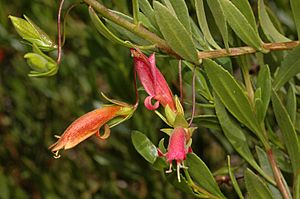Toothed eremophila facts for kids
Quick facts for kids Toothed eremophila |
|
|---|---|
 |
|
| Eremophila denticulata subsp. denticulata | |
| Conservation status | |
| Scientific classification | |
| Genus: |
Eremophila (plant)
|
| Species: |
denticulata
|
| Synonyms | |
The Eremophila denticulata, also known as the toothed eremophila or toothed poverty bush, is a special flowering plant. It belongs to the figwort family. This plant is only found, or endemic, to the southwest part of Western Australia. It grows as an upright shrub and has bright red flowers. Its leaves have unique toothed edges.
Contents
What the Toothed Eremophila Looks Like
The Eremophila denticulata is an upright shrub. It usually grows to be about 1 to 2.5 meters (3 to 8 feet) tall. Its branches and leaves are shiny and sticky. This stickiness comes from a natural resin the plant produces.
The leaves grow one after another along the stem. They are typically 34 to 60 millimeters (1.3 to 2.4 inches) long. They are also 6 to 16 millimeters (0.2 to 0.6 inches) wide. Their shape is usually oval or like a spearhead. They are a deep green color. The edges of the leaves often have small teeth. Young leaves are usually very sticky.
Flowers and Fruit
The flowers grow one by one where the leaves meet the stem. Each flower sits on a stalk that is 15 to 30 millimeters (0.6 to 1.2 inches) long. There are five green, pointed, spear-shaped sepals. These sepals are 3.5 to 13 millimeters (0.1 to 0.5 inches) long. They are also a bit sticky.
The petals are 25 to 30 millimeters (1.0 to 1.2 inches) long. They join together at the bottom to form a tube shape. The flower buds start out orange. But when they open, the flowers are a bright red. Sometimes, they can be yellow. The petal tube is mostly covered with tiny glandular hairs. The inside of the tube and the lower part have longer, softer hairs. The four stamens, which are the male parts of the flower, stick out past the end of the petal tube.
This plant flowers from August to February. After flowering, it produces fruits. These fruits are dry and oval-shaped. They have a pointed end and a papery covering. Each fruit is about 10 to 15 millimeters (0.4 to 0.6 inches) long.
How it Got its Name
The Eremophila denticulata was first officially described in 1859. This was done by a scientist named Ferdinand von Mueller. He wrote about it in his book Fragmenta phytographiae Australiae.
In 2007, another scientist, Robert Chinnock, found two different types, or subspecies, of E. denticulata. These names are now accepted by the Australian Plant Census.
- Eremophila denticulata subsp. denticulata: This type has leaves that are 34 to 60 millimeters (1.3 to 2.4 inches) long. Its fruit has a clear pointed end.
- Eremophila denticulata subsp. trisulcata: This type has smaller leaves, only 6.5 to 13 millimeters (0.26 to 0.51 inches) long. Its fruit has a blunt end.
The second part of the plant's scientific name, denticulata, comes from a Latin word. It means "finely dentate" or "very small teeth." This describes the edges of its leaves. The name trisulcata also comes from Latin. It means "three-furrowed."
Where the Plant Grows
The Eremophila denticulata subsp. denticulata is found near a town called Ravensthorpe. There was one report of it in South Australia, but this has not been confirmed.
The Eremophila denticulata subsp. trisulcata grows near Mount Buraminya and Mount Ragged. These places are inside the Cape Arid National Park.
Plant Life and Environment
Birds help to pollinate the Eremophila denticulata. This means birds carry pollen from one flower to another. This helps the plant make seeds.
The subspecies trisulcata can become rare in its natural areas. This happens if the land is not disturbed. However, after a bushfire, the number of these plants grows a lot.
Protecting the Plant
Both types of Eremophila denticulata are considered "Threatened Flora". This means they are rare and need protection. The Department of Environment and Conservation (Western Australia) has given them this status. A special plan has been made to help protect the subspecies trisulcata.
Growing Toothed Poverty Bush in Gardens
The toothed poverty bush is a popular plant to grow in gardens. It is good for larger gardens. It grows quickly. However, its branches can break in very windy places.
It is hard to grow new plants from its seeds. But it is easy to grow new plants from cuttings. Cuttings are small pieces of the plant that can grow roots. In areas with a lot of rain, it's better to graft this plant. Grafting means joining a piece of the Eremophila denticulata onto another plant, like a Myoporum species.
This plant can grow well in most types of soil. It can also handle both dry conditions and frost.


